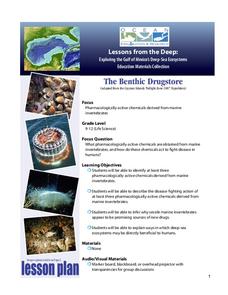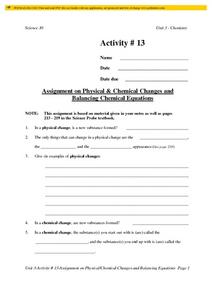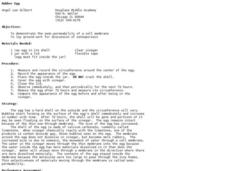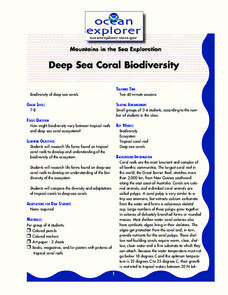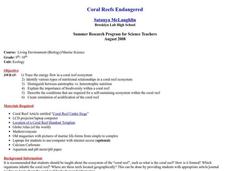Virginia Department of Education
Soap, Slime, and Creative Chromatography
Do you think chromatography paper suffers from separation anxiety? Young chemists make soap, slime, silly putty, and experiment with chromatography in this lesson. The material includes clear instructions for each experiment along with...
NOAA
Deep-Sea Ecosystems – Cool Corals
Young oceanographers research deep sea corals that thrive on chemosynthesis. The lesson focuses on the biology of the animal, preferred habitat, associations, and interactions.
NOAA
Importance of Deep-Sea Ecosystems – Chemists with No Backbones
Marine invertebrates offer us many new options for developing pharmaceutical drugs, such as w-conotoxin MVIIA, which is extracted from the cone snail and is a potent painkiller. The lesson encourages scholars to research various types of...
NOAA
Importance of Deep-Sea Ecosystems – The Benthic Drugstore
You never know what you will find next in the deep sea ecosystem. So far, scientists have found items that work as anti-tumor agents, anti-inflammatory agents, agents that stop uncontrolled cell division, and much more. The lesson begins...
NOAA
Deep-Sea Ecosystems – Life is Weird!
A pool of brine in the deep sea can be up to four times as salty as the surrounding sea water. The deep sea ecosystem relies on chemosynthesis and the organisms that live there are often strange to us. The lesson focuses on researching...
NOAA
Importance of Deep-Sea Ecosystems – How Diverse is That?
When judging diversity of an ecosystem, both species evenness and species richness must contribute. After a discussion of diversity and a guided example using the Shannon-Weaver function, scholars use the same function on two other...
Curated OER
Solving Problems Involving Percents
In this math worksheet, students solve the problems that involve the percents. Then they apply the operations to the word problems.
Curated OER
Applications With Percents
In this math worksheet, students solve the word problems using percents. They pay special attention to choosing the correct operation for each.
Curated OER
Extra Practice 11: Applications With Percents
In this percent worksheet, students read short stories, determine the information needed, write an algebraic equation and evaluate the problem. Problems include simple interest, sale price, and tax rates. There are nine percent problems...
Curated OER
Physical and Chemical Changes and Balancing Chemical Equations
In this changes worksheet, students compare and contrast the characteristics of physical and chemical changes. Students practice balancing equations. This worksheet has 5 fill in the blank and 7 short answer questions.
Curated OER
The Shape of Things
Students study the natural incubation of hens and the important characteristics of the egg shell. They perform experiments to test the strength of the dome shape of an egg and prove that an eggshell has pores to allow air to pass. ...
Curated OER
Rubber Egg
Students demonstrate the semi-permeability of a cell membrane. For this rubber egg lesson, students measure and record egg data, place the egg in jar with vinegar and close the lid, observe immediately and periodically for the next 3...
Curated OER
The Shape of Things
Middle schoolers explore dome shape construction. In this dome shape construction lesson plan, students explore the history, strength, and endurance of the dome shape design.
Curated OER
What Is an Egg Without its Shell?
Students observe osmosis, a cellular process that normally can't be observed without a microscope, and use scientific method to observe osmosis in a chicken egg.
Curated OER
Eggs: A Practical Application
Students examine the chemical and physical nature of eggs and their role in food preparation.
Curated OER
Dark and Beautiful Caves
Young scholars research how caves form. They describe the major stone formations in caves by taking notes. They construct a clay model of a cave and mark each formation making it easy to identify in the legend.
Curated OER
Build a Better Bouncer
Students experiment with silly putty. In this chemical changes lesson students work in groups, perform tests and collect data.
Curated OER
Deep Sea Coral Biodiversity
Students research life forms on tropical coral reefs in order to explore the biodiversity of the ecosystem. In this biodiversity lesson plan students work in groups and complete their coral reef activity.
Curated OER
Does Size Matter?
Students explore chemical solutions. In this chemistry lesson, students investigate the relationship between three related experiments about solutions. Students determine variables that affect the chemical concentration of each solution.
Curated OER
Coral Reefs Endangered
Students identify different types of nutritional relationships in a coral reef system and trace the energy flow. For this marine biology lesson students create a simulation of acidification of the coral reef.
Curated OER
The Giant Barrel Sponge
Students study barrel sponges. In this science and art lesson, students discuss what sponges are, create their own sponge, and share what they created with the rest of the class.
Curated OER
Observing Osmosis in a Chicken Egg
Tenth graders develop a hypothesis and explain what they observed on an activity. For this investigative lesson students observe osmosis and report their data using a graph.
Curated OER
Separation of Unknowns in a Liquid
Students identify the different components of a given sample using chromatography. In this chemistry activity, students compare paper and column chromatography. They collect data and construct data tables.
Curated OER
Periodic Table of the Elements
First graders discuss, at their level, the concept of elements making up all matter. They discover the story of Dimitri Mendeleev and his discovery of the Periodic Table of the Elements. They locate and color some of the most common...
Other popular searches
- Calcium Carbonate and Co2
- Calcium Carbonate and Rocks
- Calcium Carbonate Ocean
- Calcium Carbonate Coursework
- Calcium Carbonate With Acid
- Calcium Carbonate and Silica





